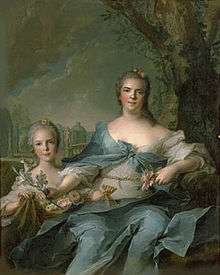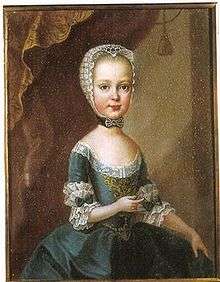Princess Isabella of Parma
| Isabella of Parma | |||||
|---|---|---|---|---|---|
 Isabella by Jean-Marc Nattier | |||||
| Born |
31 December 1741 Buen Retiro Palace, Madrid, Spain | ||||
| Died |
27 November 1763 (aged 21) Schönbrunn Palace, Vienna, Austria | ||||
| Burial | Imperial Crypt, Vienna, Austria | ||||
| Spouse | Joseph, Archduke of Austria | ||||
| Issue |
Archduchess Maria Theresa Archduchess Maria Christina | ||||
| |||||
| House | Bourbon-Parma | ||||
| Father | Philip, Duke of Parma | ||||
| Mother | Princess Louise-Elisabeth of France | ||||
Isabella of Parma (Isabella Maria Luisa Antonietta Ferdinanda Giuseppina Saveria Domenica Giovanna; 31 December 1741 – 27 November 1763) was the daughter of Infante Felipe of Spain, Duke of Parma and his wife Louise Elisabeth, eldest daughter of Louis XV of France and Maria Leszczyńska. Her paternal grandparents were Philip V of Spain (in turn a grandson of Louis XIV) and his second wife, Elisabeth of Parma.
Early life
Born Isabella Maria Luisa Antonietta Ferdinanda Giuseppina Saveria Dominica Giovanna at Buen Retiro Palace in Madrid, Isabella was an Infanta of Spain and grew up at the court of her grandfather, Philip V of Spain. Her father was the Spanish Prince Philip (1720-1765), who was Duke of Parma in Italy. Her mother was the 14 year old Elisabeth of France (1727-1759), the eldest daughter of Louis XV of France. Isabella's parents' marriage was not happy, and for nearly 10 years Isabella remained an only child. Isabella was very close to her mother and was distraught when she died of smallpox in 1759. Henceforth, Isabella was convinced she would die young, too.
Marriage
In 1760 a marriage was arranged between Isabella and Archduke Joseph of Austria, heir to the Habsburg Monarchy. After a marriage by proxy, Isabella was escorted to Austria. On 6 October 1760, at the age of 18, Isabella married Joseph II in a ceremony lasting for days. Joseph was thrilled with his new bride and overwhelmed Isabella with his love. In return, she increasingly locked herself away, so much so that shortly after their wedding, Isabella was plunged into melancholy.
Relationship with Maria Christina
The princess spent most of her time in the Viennese court, not with her husband, but with his sister, Archduchess Maria Christina, who later became, by marriage, Duchess of Saxony-Teschen. The two women loved each other deeply. During the few years Isabella and Christina knew each other, they exchanged 200 letters and "billets" while living at the same court. [1][2] They spent so much time together that they earned the comparison with Orpheus and Eurydice.
Isabel and Maria were united not only by a shared interest in music and art but also by a deep mutual love.[3] Every day they wrote long letters to each other in which they revealed their feelings of love. While the letters of Maria Christina showed her happy nature, Isabel's feelings were mixed and, in her expressions of affection, showed a certain pessimism, reflecting her growing obsession with death.
In one such letter, Isabella wrote:
- "I am writing you again, cruel sister, though I have only just left you. I cannot bear waiting to know my fate, and to learn whether you consider me a person worthy of your love, or whether you would like to throw me into the river.... I can think of nothing but that I am deeply in love. If I only knew why this is so, for you are so without mercy that one should not love you, but I cannot help myself.".[2]
In a different letter she wrote: "I am told that the day begins with God. I, however, begin the day by thinking of the object of my love, for I think of her incessantly.".[2]
Only the letters of Isabella have been preserved; those of Maria Christina were destroyed after her death.
Pregnancies and Depression
However, as wife of the heir to the throne, Isabella knew that her duty was to give birth to a healthy heir. Despite this, the princess developed disquieted feelings toward her husband, spurred by anxieties over sexual intimacy and the possibilities of pregnancy.
By late 1761, one year into the marriage, Isabella was pregnant. It was an especially difficult pregnancy, and Isabella suffered symptoms of physical illness, melancholy and lingering fears of death.* Joseph, infatuated and inexperienced, failed to fully understand his wife's misery. On March 20, 1762, after nine months of mental and physical strain, Isabella gave birth to a daughter they named Maria Theresia. Isabella remained bedridden for 6 weeks after giving birth.
In August 1762 and January 1763 Isabella suffered two separate miscarriages that aggravated her mental unrest, causing her to fall into a depression that eroded her will to live.
Isabella was six months pregnant with a baby girl when she contracted smallpox; this brought on premature labor ending in the death of the child, who was given the name Maria Christina. Isabella died a few days later. In total, out of four pregnancies, only one child survived infancy.[lower-alpha 1]
Death
In 1763, Isabella fell ill with smallpox and gave birth three months premature, on 22 November 1763, to a daughter, Maria Christina, who died a few hours after birth. A week later, Isabella followed her daughter in death at Schönbrunn Palace. She was buried in Maria Theresa's vault in the Imperial Crypt Vaults in Vienna. Joseph could not find comfort and did not recover from the death of his wife.
His second marriage (January 1765-May 1767) to Princess Maria Josepha of Bavaria was unhappy and did not produce children. Subsequently, in August 1765, Isabella's father-in-law Francis I, Holy Roman Emperor died, and Joseph succeeded him as Holy Roman Emperor with the title of Joseph II. (In 1767, Maria Josepha died of smallpox.)
Isabel had predicted even before her death that their daughter would follow this same road shortly after. Her forebodings were fulfilled on 23 January 1770, when the little Archduchess Maria Theresa died at only seven years old of pleurisy. The loss was overwhelming for Joseph. After the death of his only child, Joseph withdrew increasingly from public life.
Issue
| Name | Birth | Death | Notes |
|---|---|---|---|
| Archduchess Maria Theresa | 20 March 1762 | 23 January 1770 | Died aged 7 of pleurisy. |
| Child | August 1762 | August 1762 | Suffered a miscarriage. |
| Child | January 1763 | January 1763 | Suffered a miscarriage. |
| Archduchess Maria Christina | 22 November 1763 | 22 November 1763 | Born three months premature and died shortly after birth. |
 Family of Philip V (detail), painted in 1743 by Louis Michel van Loo; Isabella is depicted with her cousin, Princess Maria Isabella of Naples and Sicily (1743–1749).
Family of Philip V (detail), painted in 1743 by Louis Michel van Loo; Isabella is depicted with her cousin, Princess Maria Isabella of Naples and Sicily (1743–1749). Isabella and her mother in 1750
Isabella and her mother in 1750
 The arrival of Isabella to Vienna held at the Schönbrunn Palace
The arrival of Isabella to Vienna held at the Schönbrunn Palace Archduchess Maria Theresa of Austria, her only surviving child
Archduchess Maria Theresa of Austria, her only surviving child
Titles and styles
- 31 December 1741 – 18 October 1748: Doña Isabel, Infanta of Spain
- 18 October 1748 – 7 September 1760: Princess Isabella of Parma
- 7 September 1760 – 27 November 1763: Archduchess Isabella, Princess Imperial of Austria, Princess Royal of Hungary and Bohemia
Ancestry
| Ancestors of Princess Isabella of Parma |
|---|
|
|
Notes
- ↑ Historically, childbirth was the leading cause of death for women, as many as 1:5, until the mid 20th century.[4]
References
- ↑ Archives Nationales de Vienne, Autriche; Der Gruftwächter, play by Kafka; Simon Sebag Montefiore,Catherine the Great and Potemkin: The Imperial Love Affair, London, 2010
- 1 2 3 Justin C. Vovk,In Destiny's Hands: Five Tragic Rulers, Children of Maria Theresa, USA, 2010
- ↑ Farquhar, Michael (2001). A Treasury of Royal Scandals: The Shocking True Stories of History's Wickedest, Weirdest, Most Wanton Kings, Queens, Tsars, Popes, and Emperors. Penguin Books. p. 91. ISBN 9780140280241.
- ↑ http://www.hugoschwyzer.net/2012/05/25/mens-desire-womens-death-do-historical-rates-of-maternal-death-affect-our-views-of-sexuality-today/
External links
- Isabella von Bourbon-Parma from German Wikipedia. Retrieved 6 August 2006.
- Biography of the melancholy Princess Isabella of Parma (1741-1763). Retrieved 6 August 2006
- Vovk, Justin C. (2008). In Destiny's Hands: Five Tragic Rulers, Children of Maria Theresa.
.svg.png)